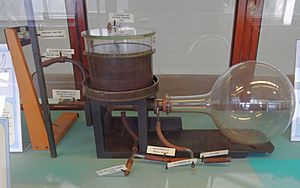Charles Thomson Rees Wilson facts for kids
Quick facts for kids
Charles Thomson Rees Wilson
|
|
|---|---|

Wilson in 1927
|
|
| Born | 14 February 1869 Glencorse, Scotland
|
| Died | 15 November 1959 (aged 90) Carlops, Scotland
|
| Alma mater |
|
| Known for |
|
| Awards |
|
| Scientific career | |
| Fields | Physics |
| Institutions | Sidney Sussex College, Cambridge |
| Academic advisors | J. J. Thomson |
| Doctoral students | |
Charles Thomson Rees Wilson (born February 14, 1869 – died November 15, 1959) was a Scottish physicist and meteorologist. He is famous for inventing the cloud chamber, which helped scientists study tiny particles. For this amazing invention, he won the Nobel Prize in Physics.
Contents
Early Life and School
Charles Wilson was born in a place called Glencorse, Scotland. His father was a sheep farmer. When Charles was only four years old, his father passed away. After that, his family moved to Manchester.
With help from his step-brother, Charles went to Owens College. He first studied biology because he wanted to become a doctor. He earned his science degree in 1887. Later, he won a scholarship to Sidney Sussex College, Cambridge. There, he became very interested in physics and chemistry. He did very well in his science studies in 1892.
A Career in Science
Charles Wilson became very interested in meteorology, which is the study of weather and the atmosphere. In 1893, he started to study clouds and how they form.
From 1894, he worked at an observatory on Ben Nevis, a famous mountain in Scotland. He watched how clouds formed there. He was especially amazed by "glories," which are colorful rings of light seen around a shadow in mist or fog.
The Cloud Chamber
Wilson wanted to create these cloud effects in a lab. He worked at the Cavendish Laboratory in Cambridge. He tried expanding humid air in a sealed container. This led him to invent the cloud chamber.
He later found that tiny charged particles called ions could help clouds form inside his chamber. These ions were created by radioactivity. His cloud chamber became a very important tool for scientists.
Wilson became a Fellow at Sidney Sussex College in 1900. He also taught at the university. Some people found him a difficult lecturer because he had a noticeable stutter.
Big Discoveries
The cloud chamber was Charles Wilson's most important invention. It earned him the Nobel Prize in Physics in 1927. The Cavendish laboratory praised him for creating a new way to study charged gases.
The cloud chamber allowed scientists to make huge steps forward. They could now study tiny subatomic particles and learn about particle physics. Some people believe Wilson's invention made it possible to study these particles at all.
Wilson wrote many scientific papers about weather and physics. He wrote about X-rays, ionization, and how thunderclouds form. He might have even seen a sprite in 1924. Sprites are huge flashes of light high above thunderclouds, but they were not officially discovered until much later. Weather was a key part of his work throughout his life. His last paper was even about thunderclouds.
How He Studied Science
Scientists have looked back at how Wilson did his experiments. He combined different ways of studying things. Some scientists believed you should only observe nature as it is. Others thought experiments in a lab were best. Wilson used both methods in his work.
His work helped make things "visible" that scientists had only guessed about before. He has been called "almost the last of the great individual experimenters in physics." He used his cloud chamber to show how things like subatomic particles and X-rays worked. But his main interest was always meteorology.
Awards and Legacy
Wilson was chosen as a Fellow of the Royal Society (FRS) in 1900.
He won the Nobel Prize in Physics in 1927 for inventing the cloud chamber. He shared the prize with American physicist Arthur Compton. Compton was rewarded for his work on how radiation acts like particles.
Even though Wilson made big contributions to particle physics, he stayed interested in atmospheric electricity his whole life. This is the study of electrical events in the atmosphere, like lightning. For example, his last research paper was published in 1956. He was in his late eighties at the time! It was about atmospheric electricity.
Many things are named after him:
- The Wilson crater on the Moon is partly named after him.
- The Wilson Condensation Cloud formations, which happen after big explosions like nuclear detonations, are also named after him.
- The Wilson Society at Sidney Sussex College, Cambridge, is named in his honor.
- The CTR Wilson Institute for Atmospheric Electricity is named after him too.
His old papers and research notes are kept at the Archives of the University of Glasgow. In 2012, the Royal Society of Edinburgh held a special meeting to honor Wilson. They called him the "Great Scottish Physicist."
Personal Life
In 1908, Charles Wilson married Jessie Fraser. She was the daughter of a minister from Glasgow. They had four children together. His family remembered him as a patient and curious person. He loved taking walks in the hills near his home. He passed away at his home in Carlops on November 15, 1959, surrounded by his family.
|
See also
 In Spanish: Charles Wilson para niños
In Spanish: Charles Wilson para niños




